About Me
I am an PhD Student in the General Robotics Lab at Duke MEMS Department, advised by Dr. Boyuan Chen. My research focuses on learning-based methods for mobile robots, emphasizing on system adaptability and perception robustness for field robots. Before that, I completed both my MPhil and BEng (1st Hons) at The Hong Kong Polytechnic University, mentored by Prof. Chih-Yung Wen and Dr. Boyang Li. My MPhil research was supported by the Presidential Fellowship, while my undergraduate studies were fully sponsored by the PolyU APEC Entry Scholarship. In between, I was affiliated with the Hong Kong Center for Construction Robotics (HKCRC), a research institute headed by Prof. Zexiang Li. Ping me if you’d like to chat about robotics — or just have a conversation! I won't bite :)
Project Highlights
a) Improving Adaptability of Koopman Operators for Underactuated Robots
 Ongoing project focused on developing a Koopman operator-based controller for underactuated robots (e.g., quadrotors and quadrupeds) through hyperparameter optimization using reinforcement learning (RL). The algorithms and methods (subject to finalization) include Extended Dynamic Mode Decomposition (EDMD) for Koopman observables, regression for the Koopman operator, and Proximal Policy Optimization (PPO) for adaptive hyperparameter inference in the controller.
Ongoing project focused on developing a Koopman operator-based controller for underactuated robots (e.g., quadrotors and quadrupeds) through hyperparameter optimization using reinforcement learning (RL). The algorithms and methods (subject to finalization) include Extended Dynamic Mode Decomposition (EDMD) for Koopman observables, regression for the Koopman operator, and Proximal Policy Optimization (PPO) for adaptive hyperparameter inference in the controller.
b) A Bootcamp for Legged Robotics via Biped and Quadruped Simulation (Code)
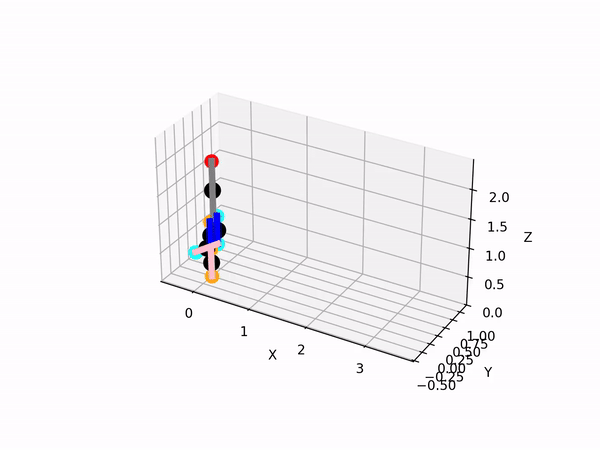 Self-implemented biped simulator with impedance control and a gait controller for a quadruped using Gazebo ROS. Algorithms and methods employed include Euler-Lagrange modeling, the RK Dormand–Prince method, fixed-point searching on Poincaré maps, forward and inverse kinematics, trajectory optimization with polynomials, feedback linearization, quadratic programming, and cycloid trajectories.
Self-implemented biped simulator with impedance control and a gait controller for a quadruped using Gazebo ROS. Algorithms and methods employed include Euler-Lagrange modeling, the RK Dormand–Prince method, fixed-point searching on Poincaré maps, forward and inverse kinematics, trajectory optimization with polynomials, feedback linearization, quadratic programming, and cycloid trajectories.
c) Experimental Non-Robocentric Dynamic Landing of Quadrotor UAVs with On-Ground Sensor Suite (Code PDF)
 Conducted research on an autonomous landing system for UAVs without onboard vision sensors. Algorithms and methods utilized include SE(3) relative estimation, the iterated extended Kalman filter, quadrotor dynamic modeling, minimum-jerk trajectory optimization, Bézier curves, and a non-inertial PID-feedforward outer-loop controller.
Conducted research on an autonomous landing system for UAVs without onboard vision sensors. Algorithms and methods utilized include SE(3) relative estimation, the iterated extended Kalman filter, quadrotor dynamic modeling, minimum-jerk trajectory optimization, Bézier curves, and a non-inertial PID-feedforward outer-loop controller.
d) Fixed-Time Adaptive Consensus Control for Multi-Quadrotor Subject to External Disturbances Via Deep Reinforcement Learning
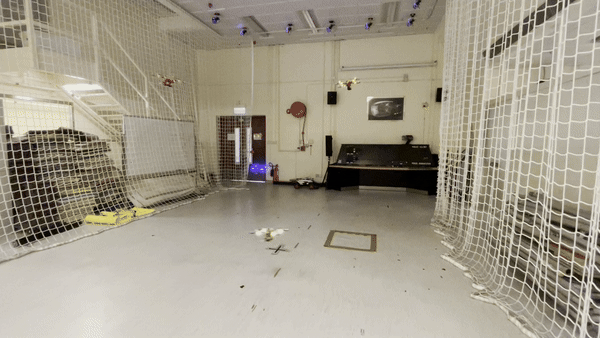 Contributed to a research project on adaptive control for formation control of UAV swarms. Algorithms and methods employed include sliding-mode control on graph topology, nonlinear disturbance observers, reinforcement learning (RL) for hyperparameter tuning, quadrotor dynamic modeling, Lyapunov stability analysis, and physical experiments with UAV swarms involving communication.
Contributed to a research project on adaptive control for formation control of UAV swarms. Algorithms and methods employed include sliding-mode control on graph topology, nonlinear disturbance observers, reinforcement learning (RL) for hyperparameter tuning, quadrotor dynamic modeling, Lyapunov stability analysis, and physical experiments with UAV swarms involving communication.
e) An Adaptive Model Predictive Control for Unmanned Underwater Vehicles subject to External Disturbances and Measurement Noise (Code PDF)
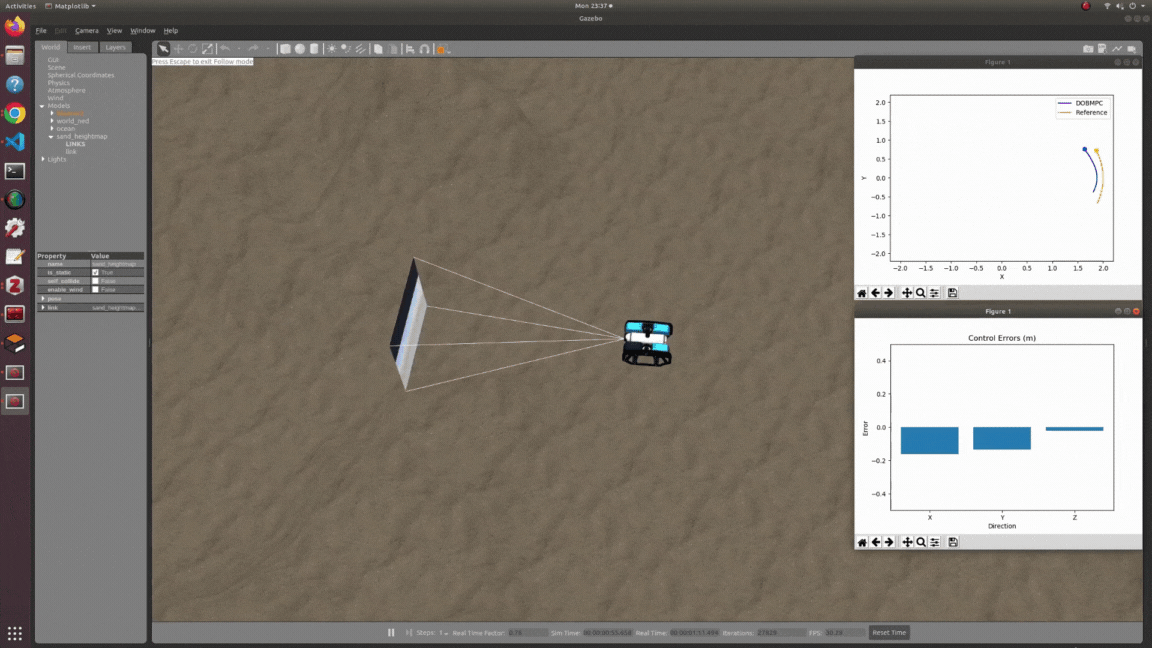 Developed an adaptive model predictive controller (MPC) for an unmanned underwater vehicle (UUV) using an error-state extended state observer. Algorithms and methods employed include lumped disturbance observation, error-state space tracking and estimation, Lyapunov stability analysis, and nonlinear MPC.
Developed an adaptive model predictive controller (MPC) for an unmanned underwater vehicle (UUV) using an error-state extended state observer. Algorithms and methods employed include lumped disturbance observation, error-state space tracking and estimation, Lyapunov stability analysis, and nonlinear MPC.
f) Toy Convex Solver (Code PDF)
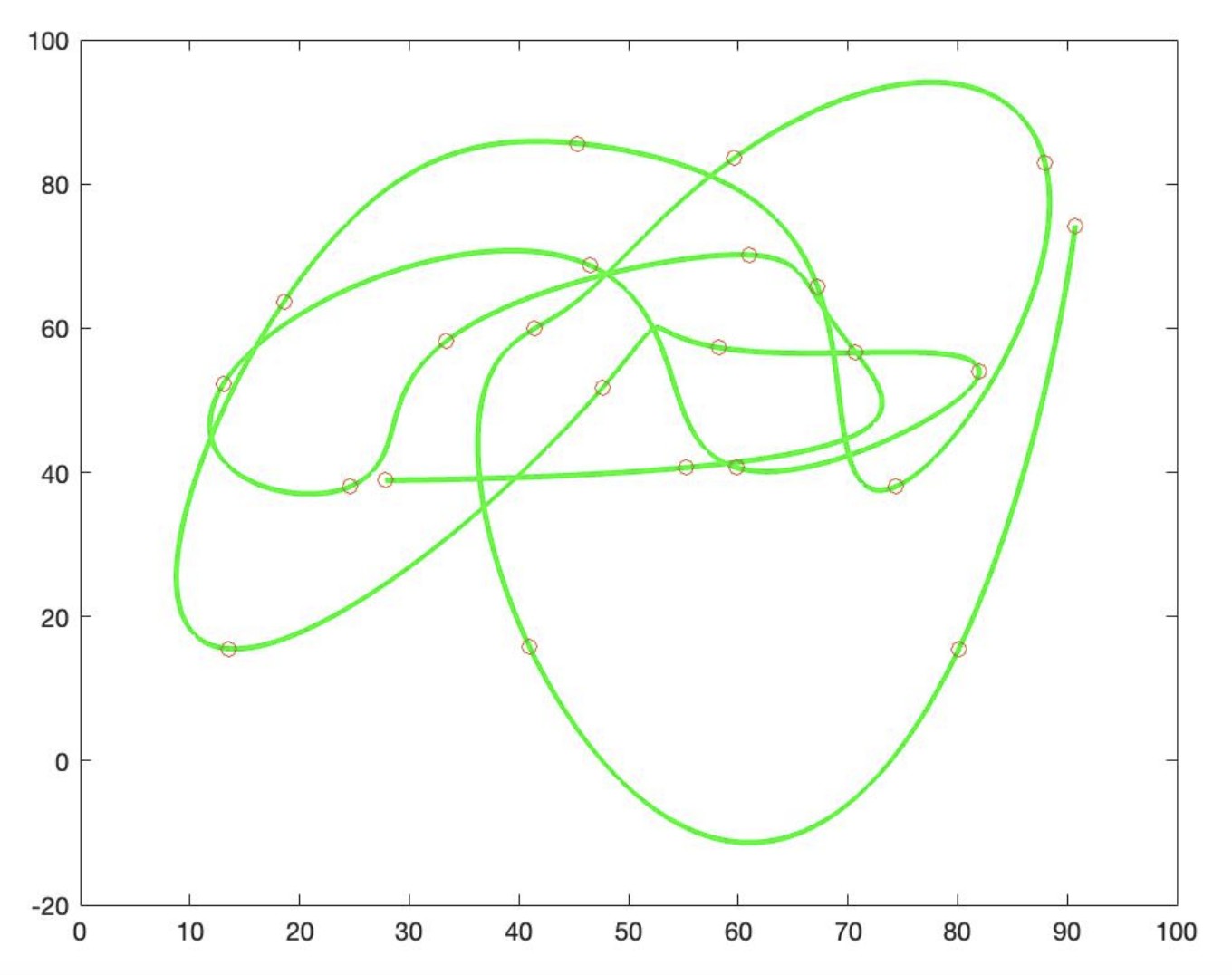 Self-implemented a convex solver for equality-constrained minimum-snap trajectory optimization. Algorithms and methods employed include the infeasible start Newton's method and convergence analysis.
Self-implemented a convex solver for equality-constrained minimum-snap trajectory optimization. Algorithms and methods employed include the infeasible start Newton's method and convergence analysis.
g) An Autonomous UGV with LOAM (Code-SITL Code-Firmware)
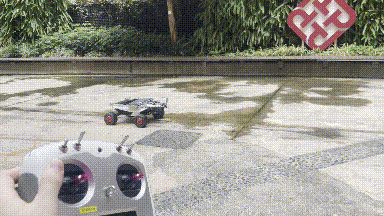 This implementation showcases an autonomous UGV that employs an open-source LOAM algorithm and a custom-developed nonholonomic car controller utilizing PID-feedforward control. The system was demonstrated on the AgileX Mini platform. Additionally, the corresponding Gazebo SITL simulation environment, including the controller, is maintained and open-sourced.
This implementation showcases an autonomous UGV that employs an open-source LOAM algorithm and a custom-developed nonholonomic car controller utilizing PID-feedforward control. The system was demonstrated on the AgileX Mini platform. Additionally, the corresponding Gazebo SITL simulation environment, including the controller, is maintained and open-sourced.
h) Bug Planner Implementation for Nonholonomic Planner Robots (Code)
 This is an implementation of a nonholonomic path planner for robots during my undergraduate studies. Algorithms and methods employed include 2D lidar scan data processing, 2D wheel robot dynamic modeling, the Bug algorithm for path planning, and 2D wheel robot PID control.
This is an implementation of a nonholonomic path planner for robots during my undergraduate studies. Algorithms and methods employed include 2D lidar scan data processing, 2D wheel robot dynamic modeling, the Bug algorithm for path planning, and 2D wheel robot PID control.
i) Autonomous Dynamic Object Tracking/Following UAV (Code PDF)
 My honours project during my Bachelor's studies, where I designed a UAV capable of tracking and following dynamic objects. Algorithms and methods employed include DNN (YOLO) implementation and training, linear Kalman filter, and visual servoing with PID.
My honours project during my Bachelor's studies, where I designed a UAV capable of tracking and following dynamic objects. Algorithms and methods employed include DNN (YOLO) implementation and training, linear Kalman filter, and visual servoing with PID.
Selected Publication
- L.-Y. Lo, B. Li, C.-Y. Wen, and C.-W. Chang, “Experimental Non-Robocentric Dynamic Landing of Quadrotor UAVs with On-Ground Sensor Suite,” IEEE Transactions on Instrumentation and Measurement (TIM), vol. 73, 2024. (link)
- L.-Y. Lo, Y. Hu, B. Li, C.-Y. Wen, and Y. Yang, “An adaptive model predictive control for unmanned under-water vehicles subject to external disturbances and measurement noise,” in 2024 14th Asian Control Conference (ASCC). IEEE, 2024, pp. 01–07. (link)
- Y. Yang, K. Liu, L.-Y. Lo, T. Huang, Y. Fu, and C.-Y. Wen, “Fixed-time adaptive consensus control for multi-quadrotor subject to external disturbances via deep reinforcement learning,” submitted to IEEE Transactions on Automation and Science Engineering (TASE), 2024.
- W. Yang, Z. Tan, Y. Xue, L.-Y. Lo, K. Liu, and C.-Y. Wen. “Hierarchical 3D scene graph based metric semantic slam for object mapping and counting,” submitted to IEEE Transactions on Circuits and Systems II: Express Briefs, 2024.
- L.-Y. Lo, B. Li, C.-Y. Wen, and C.-W. Chang, “Landing a quadrotor on a ground vehicle without exteroceptive airborne sensors: A non-robocentric framework and implementation,” in 2023 IEEE 26th International Conference on Intelligent Transportation Systems (ITSC). IEEE, 2023, pp. 6080–6087. (link)
- L.-Y. Lo, C. H. Yiu, Y. Tang, A.-S. Yang, B. Li, and C.-Y. Wen, “Dynamic object tracking on autonomous uav system for surveillance applications,” Sensors, vol. 21, no. 23, p. 7888, 2021. Editor’s Choice Article. (link)
